The distortion rise seems to be voltage related because the power level it happens at is about 2x at 4 ohms vs 8 ohms. I agree that it is probably related to the TinySine implementation because I didn't see it in the ASR review of the Aiyima A05 that uses the same amp chip, your observation regarding the datasheet, and the fact that similarly performing amps recently tested do not show a step change in that region (which might indicate an analyzer or load issue).
DAC Underflow is some packet loss during the analyzer's acquisition process. For the dashboard tests, I run a pretty large FFT size and fast sample rate to improve resolution. I do a number of readings to make sure the data is stable before I stop and take a snapshot - but sometimes it still winds up reporting a DAC Underflow. Severe ones are obvious, but the more minor ones aren't really noticeable and that's what probably happened with the scan in question.
I do a need a bigger variable power supply for these amp board tests. Right now, I have a 0-60V supply, but max current is only 5A and I'm running into a lot of amps that need more than that into 4 ohm loads to really show what they can do. I have a few random higher current switching supplies around, but they don't cover everything I need. For this amp, I have a 24V supply I can adjust up to about 27V and a 36V supply I can adjust down to just under 32V - but I don't have 30V with enough current to do 100W x 2 into 4 ohms. It will be fixed.
Keep an open mind, but don't let your brain fall out.
The long term strategy of having a really nice lab power supply fall into my lap hasn't bore any fruit just yet, but in the mean time, I decided to see what could be had for a relatively painless price. Enter the VIXKPIRR (random letter generator?) adjustable 0-48V power supply 12.5A 600W. As spec'ed this should cover most every amp board currently out there. It has the form factor of a regular switching power supply, but has real adjustment knobs, a voltage and current display, and a power switch which is a lot better than having to plug and unplug the supply before and after testing.
The first thing to do is see if the voltage readout is accurate. I was pleasantly surprised on that front.
With that, it's time to try some different voltages with the TinySine amp. The data sheet advertises an unusually wide range of operating voltages (12V to 30V). I decided to try a few common voltages.
13.8V - Mobile audio
19V - Typical old laptop power supply
24V - Relatively common power supply, battery voltage
30V - Max voltage
Here are the results at 1 kHz with a 4 ohm and 8 ohm load respectively.
This is a summary table of the power and THD+N at the point where the primary distortion rise starts.
My takeaways:
At 13.8V, this would perform a lot like a decent mobile audio head unit.
At 19V and 24V, this performs a lot like a typical TPA3116 amp board
The big advantage is that this can be pushed to 30V for more power.
If 1% THD+N is allowed, this can reasonably be considered a 50W into 8 ohms, 100W into 4 ohms amp.
There are some other things to test, which will be coming soon:
Is there a performance impact if the bluetooth board is removed?
How do the gain settings impact performance (there are 4 available via DIP switches)?
I also want to look at the DSP programming, which will be a bit of a learning curve.
Keep an open mind, but don't let your brain fall out.
Have you looked at the output of that power supply? I've seen some that were horribly noisy, but something like a Micro Audio is very quiet. Anyway I'm not sure what affect, if any, it would have on these little amp boards.
Looks very promising if one can get a nice 30V PSU like you have got.
IMHO the 30W/48W into 8/4 ohm rating is probably the sweet spot, what with the more commonly available 24V power supplies.
With 24 vs 30V, the voltage/power loss equates to about 2dB less gain/amplification. This not a deal breaker because 30W in 8 ohms is usually a bit more than what most 5-8” midwoofers can take before they start to complain (~100dB SPL, higher amounts of non-linear distortion) or unload below the port tuning frequency of a vented box.
The bluetooth board is connected to the ADAU1701 via i2s, which is like SPDIF with a dedicated clock signal. Unless the BT board is electrically noisy, I wouldn't expect any radical changes to the performance with its removal.
The 1701 is the DSP used in the original miniDSP 2x4--the "non-HD" version. That original miniDSP was somewhat maligned for its THD+N, which the spec sheet claims is -83dB for its ADCs and -90dB for the DACs (before implementation). So in theory, the Bluetooth input has the potential to be a cleaner since it bypasses the ADC step. I've wanted to connect a Raspberry Pi directly to one of these boards via i2s for that very reason.
Bluetooth seems to have some slight artifacts that may be noticeable on critical listening. The interesting thing about the Tinysine boards is that they have coaxial or optical inputs modules,
“If you replace the AudioB Bluetooth module with this TOSLINKBee. The whole amplifier will becomes a new TOSLINK input amplifier board.”
No affiliation with Tinysine. Obviously modules with selectable inputs would be cool (and raise costs) but this is probably the nice option for connecting to, say a TV with an optical output.
@ugly_woofer said:
Have you looked at the output of that power supply? I've seen some that were horribly noisy, but something like a Micro Audio is very quiet. Anyway I'm not sure what affect, if any, it would have on these little amp boards.
I haven't analyzed the output of the supply itself. but will take a look at a good/safe way to do that. At this point, I can compare data between the new variable supply and the previously used 24V Meanwell supply as I have dashboard datasets for both at 24V.
First, the Meanwell
And the variable supply...
So, it's safe to say that the results are equivalent in this case - but that doesn't rule out the possibility that a different board would react differently.
Keep an open mind, but don't let your brain fall out.
@Dirk said:
The bluetooth board is connected to the ADAU1701 via i2s, which is like SPDIF with a dedicated clock signal. Unless the BT board is electrically noisy, I wouldn't expect any radical changes to the performance with its removal.
That corresponds well with what I observed. I took some measurements with the bluetooth board off.
Here is the same 24V supply voltage dashboard as the two in the previous post, but with the bluetooth board removed. No significant difference.
Keep an open mind, but don't let your brain fall out.
The Tinysine DSP program uses a threshold detector to switch between the analog and BT inputs. This is from their program. Some OEMs just sum the inputs where Tinysine actually switches them.
I haven't done too much research in a while, but if I was to get TPA325x I'd probably go with 3eaudio. (I have their first generation 3255 and 3351 but haven't used them). More than $60 though.
It seems to use the ACP Workbench app, which wouldn’t load on my previous PC, so I couldn’t tell you what the interface/options are like.
I cannot find data to support an opinion concerning the technical performance of the linked amps and I wont speculate. They do offer DSP EQ/XO and BT/Analogue-in though.
I thought they were interesting.
Aside, and no intention of derailing this thread but having powered DSP amps on the backs of cabinets and all of its attendant wiring and complexity has me just going back to a centralized Audio Source/DSP/Amp location with multi conductor cable to the speakers - much cleaner and less complicated.
@tktran said:
What’s the cost of an ICE board these days with equivalent power?
I’m looking for stereo amplification and DSP and Bluetooth/digital in. For $60 a I wasn’t aware of any other solution.
An extra 10dB SNR and 3dB of gain (double power) would be handy.
100Wx2 for about $140 USD from PE--which SOUNDS like a lot on the surface, but a.) the performance is solid and b.) it brings its own integrated power supply. To keep the rest of the budget down, front it with one of the $25 Dayton bluetooth boards. I'm sure Wondom has an equivalent if the Dayton is off the table as far as customs. (edit: This guy would be ideal)
So, you're in for less than $175 from AliExpress. And those amps are a true 100W x 2 @ 4 ohms (1% THD) and the THD+N is three decimal places. I've had my ear right up to one connected to a Seas DXT, and it was dead silent. I can't say that for any other single board solution I've tried.
For DSP boards, I haven't found anything between the Tinysine/Wondom/Arylic and ICE+external DSP, and that's a shame. I know high power numbers at low prices sell for the average consumer, but if you're the sort of bloke to buy an amp with DSP capabilities that have to be programmed, I think you're also the sort of customer willing to spend a little extra for better audio performance. Another brutal reminder that the world does not regularly cater to my whims.
It seems to use the ACP Workbench app, which wouldn’t load on my previous PC, so I couldn’t tell you what the interface/options are like.
How is it? Easier to apply settings than Sigma, but the full capabilities require Mandarin fluency. Their "bass expander" algo is really good though. Makes an FE85 sound way bigger than it actually is.
For what it is worth, the TinySine amp has 4 gain settings. I did some testing to see if lower gain would improve performance or to what extent higher gain might hurt it. My previous measurements were at the second highest gain setting, which I will refer to as gain 2 to align with the DIP switch setting. I will start with the summary chart and some observations.
The first observation is that the measured gains were quite a bit lower than those advertised on the data sheet. Even the highest gain is somewhat lower than a typical amp board, which will be in the 27-30 dB range. The Aiyima A05, tested on Audio Science Review, had a gain of about 23 dB and similar performance. The A05 had tone controls, but not bluetooth or DSP capability, so it looks like the TinySine board managed to add that functionality without having much impact on performance.
With the lowest two gain settings, I could not drive the board to full power. With the higher two gain settings, power is likely equivalent. My test points are 1 dBV apart and the different gains had the points fall at somewhat different power levels. Here are the power curves.
Last, I do have the dashboard charts for each of the 4 gain settings. Since they report gain, it should be clear which represents which setting. The noise floor does get lower as gain is reduced. One thing I found noteworthy is at the lowest gain setting, we see a peak start to emerge at 60 Hz, which must be power supply related. I was pretty encouraged that the 60 Hz peak is more than 90 dB down from the fundamental 1 kHz tone.
Keep an open mind, but don't let your brain fall out.
I’m all for the separate DSP, amp and sources. I was a bit late getting into integrated DSPs, by the time I got around to trying the miniDSP 4x10HD championed JohnK a decade ago, it was discontinued. So I had to wait for Flex 8, which I am more than pleased with.
Here’s the test result from miniDSP’s website:
But every so often someone younger than me complains that they can’t connect its Bluetooth easily.
My kids are the age where they speak to their speakers…
So I think these all in one affordable amps/DSP/Bluetooth have their use cases. Like if one is building with scrap MDF or 3D printed casing and $20 mid-woofers and $10 tweeters, it’s a bit unreasonable to using 3 figure amp. But you can still get very good sound for a kids/college dorm room.
But DIYers are certainly playing catch-up because we don’t have access to these advanced products in unit quantities. Scott is working hard to find things that are sold at retail; because all the manufacturers are going straight for B2B. The most DIY friendly all in one board is the Hypex Fusion plate amps but last time I spoke to Hypex they had no plans for Wireless; True Wireless Stereo, or Bluetooth, let alone the more advanced lossless wireless protocols.
Could you attempt to measure something for me using your fancy new jig ?
Could you please measure the peak voltage drop across your speaker terminals (assuming passive crossover installed) using MUSIC under "normal" listening volume and "Loud" listening volume?
I.... have been somewhat able to do this with a multimeter, but I was not confident in the sampling window. Curt C. made me MUCH smarter about counts and resolution and such. Curt is terrific ! A valid measurement solution would be a recording Oscilloscope at about $500, but if your Jig will do this - great ! I think I would get much more use from a QA403 than an Oscilloscope.
The end goal for me is building an amplifier just big enough to produce the necessary voltage/wattage.
If you are able to do this - great !
If your QA403 won't measure peak music voltage, please convey this too.
I think it should be able to do that. I can tap off the speaker terminals from a music system and feed a signal back to the QA403. The 403 can track peak and RMS voltage with its standard software. The analyzer doesn't want to see more than 32 dBV (about 40V), which I don't think will be an issue. If it is, I will need to use attenuated probes.
I think the worst case speakers I have on hand for testing from a voltage perspective are the Argons which are 8 ohms and about 80 dB (2.83V, 1m) sensitivity. I also have the Hafniums, which are similarly insensitive, but just under 4 ohms at their lowest impedance around 100 Hz.
Keep an open mind, but don't let your brain fall out.
You could use a voltage divider circuit to half the amplifier output voltage and then correct the readings manually by doubling the voltage readings.
I would also be curious what the readings are dummy load vs a dynamic load. Some say that a speaker that is easier to drive will sound better. For some amplifiers I am sure that this is true but for most modern amplifiers they should be able to control the inductive swings with little to no degradation in sound quality.
"Crossovers may be implemented either as passive RLC networks, as active filters with operational amplifier circuits or with DSP engines and software. The only excuse for passive crossovers is their low cost. Their behavior changes with the signal level dependent dynamics of the drivers. They block the power amplifier from taking maximum control over the voice coil motion. They are a waste of time, if accuracy of reproduction is the goal."
While Sigfried was way smarter than I will ever be I don't agree with this statement as an absolute. There are a plethora of examples where both the speaker and the amplifier benefit from passive components. A class D couldn't even function without an LC circuit...
If we look at power filter circuits used on other electronics we see the same components inductors, capacitors and resistors. Power filtration and controll is never done with active components alone, especially when precision is required.
Passive components are a nessisary evil.
I posted that quote just to get a reaction. I admire SL for all of his work. but I'm really more of the "It's just a matter of execution" guy. Active, passive it's all about how it's executed.
How long have active systems with affordable software even been available to the average Joe? Certainly a mere minute fraction of the time passive crossovers have been around. It's like history isn't a thing.
@Ed_Perkins said:
I posted that quote just to get a reaction. I admire SL for all of his work. but I'm really more of the "It's just a matter of execution" guy. Active, passive it's all about how it's executed.
I use both, so I’m maybe about ½ right…. But reading his quote, as stated relating to crossovers, “I’ll take the Siegfried category on crossovers, for $200, Alex”
Comments
The distortion rise seems to be voltage related because the power level it happens at is about 2x at 4 ohms vs 8 ohms. I agree that it is probably related to the TinySine implementation because I didn't see it in the ASR review of the Aiyima A05 that uses the same amp chip, your observation regarding the datasheet, and the fact that similarly performing amps recently tested do not show a step change in that region (which might indicate an analyzer or load issue).
DAC Underflow is some packet loss during the analyzer's acquisition process. For the dashboard tests, I run a pretty large FFT size and fast sample rate to improve resolution. I do a number of readings to make sure the data is stable before I stop and take a snapshot - but sometimes it still winds up reporting a DAC Underflow. Severe ones are obvious, but the more minor ones aren't really noticeable and that's what probably happened with the scan in question.
I do a need a bigger variable power supply for these amp board tests. Right now, I have a 0-60V supply, but max current is only 5A and I'm running into a lot of amps that need more than that into 4 ohm loads to really show what they can do. I have a few random higher current switching supplies around, but they don't cover everything I need. For this amp, I have a 24V supply I can adjust up to about 27V and a 36V supply I can adjust down to just under 32V - but I don't have 30V with enough current to do 100W x 2 into 4 ohms. It will be fixed.
Sehlin Sound Solutions
TinySine TSA8802B(Apt-X) follow up...
The long term strategy of having a really nice lab power supply fall into my lap hasn't bore any fruit just yet, but in the mean time, I decided to see what could be had for a relatively painless price. Enter the VIXKPIRR (random letter generator?) adjustable 0-48V power supply 12.5A 600W. As spec'ed this should cover most every amp board currently out there. It has the form factor of a regular switching power supply, but has real adjustment knobs, a voltage and current display, and a power switch which is a lot better than having to plug and unplug the supply before and after testing.

The first thing to do is see if the voltage readout is accurate. I was pleasantly surprised on that front.
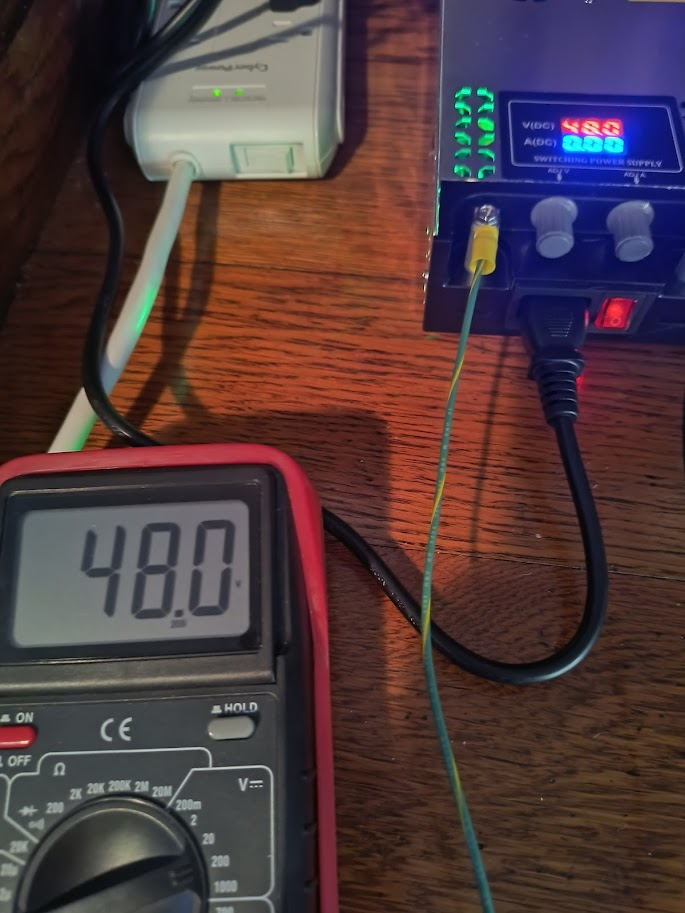
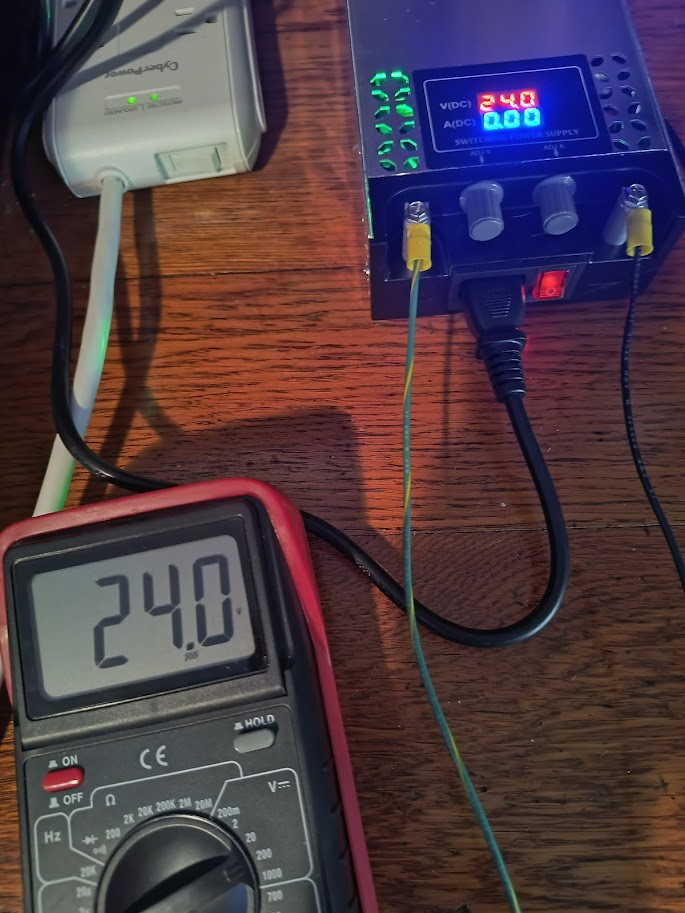
With that, it's time to try some different voltages with the TinySine amp. The data sheet advertises an unusually wide range of operating voltages (12V to 30V). I decided to try a few common voltages.
13.8V - Mobile audio
19V - Typical old laptop power supply
24V - Relatively common power supply, battery voltage
30V - Max voltage
Here are the results at 1 kHz with a 4 ohm and 8 ohm load respectively.
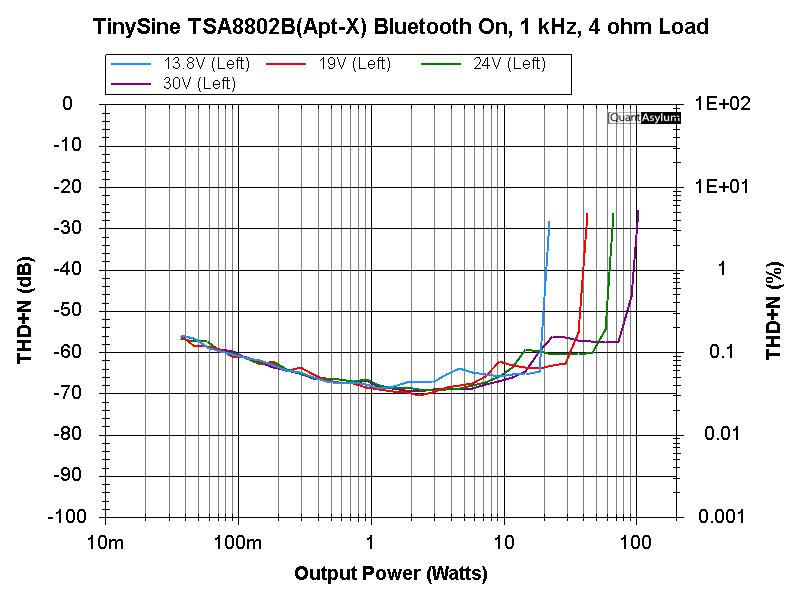

This is a summary table of the power and THD+N at the point where the primary distortion rise starts.
My takeaways:
There are some other things to test, which will be coming soon:
I also want to look at the DSP programming, which will be a bit of a learning curve.
Sehlin Sound Solutions
Have you looked at the output of that power supply? I've seen some that were horribly noisy, but something like a Micro Audio is very quiet. Anyway I'm not sure what affect, if any, it would have on these little amp boards.
Thanks for the test results!
Looks very promising if one can get a nice 30V PSU like you have got.
IMHO the 30W/48W into 8/4 ohm rating is probably the sweet spot, what with the more commonly available 24V power supplies.
With 24 vs 30V, the voltage/power loss equates to about 2dB less gain/amplification. This not a deal breaker because 30W in 8 ohms is usually a bit more than what most 5-8” midwoofers can take before they start to complain (~100dB SPL, higher amounts of non-linear distortion) or unload below the port tuning frequency of a vented box.
Eg. 16V in 8 ohm = 32W
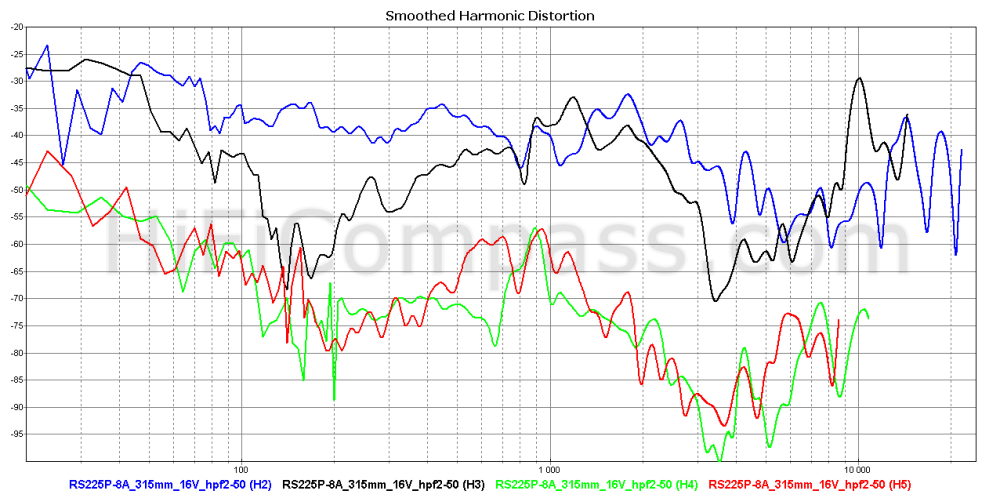
Reference:
https://hificompass.com/en/speakers/measurements/dayton-audio/dayton-audio-rs225p-8a
The bluetooth board is connected to the ADAU1701 via i2s, which is like SPDIF with a dedicated clock signal. Unless the BT board is electrically noisy, I wouldn't expect any radical changes to the performance with its removal.
The 1701 is the DSP used in the original miniDSP 2x4--the "non-HD" version. That original miniDSP was somewhat maligned for its THD+N, which the spec sheet claims is -83dB for its ADCs and -90dB for the DACs (before implementation). So in theory, the Bluetooth input has the potential to be a cleaner since it bypasses the ADC step. I've wanted to connect a Raspberry Pi directly to one of these boards via i2s for that very reason.
Bluetooth seems to have some slight artifacts that may be noticeable on critical listening. The interesting thing about the Tinysine boards is that they have coaxial or optical inputs modules,
“If you replace the AudioB Bluetooth module with this TOSLINKBee. The whole amplifier will becomes a new TOSLINK input amplifier board.”
Available for a bit over a Hamilton.
https://www.tinyosshop.com/index.php?route=product/product&path=158_192&product_id=1167
https://www.tinyosshop.com/index.php?route=product/product&path=158_192&product_id=1182
No affiliation with Tinysine. Obviously modules with selectable inputs would be cool (and raise costs) but this is probably the nice option for connecting to, say a TV with an optical output.
I haven't analyzed the output of the supply itself. but will take a look at a good/safe way to do that. At this point, I can compare data between the new variable supply and the previously used 24V Meanwell supply as I have dashboard datasets for both at 24V.
First, the Meanwell
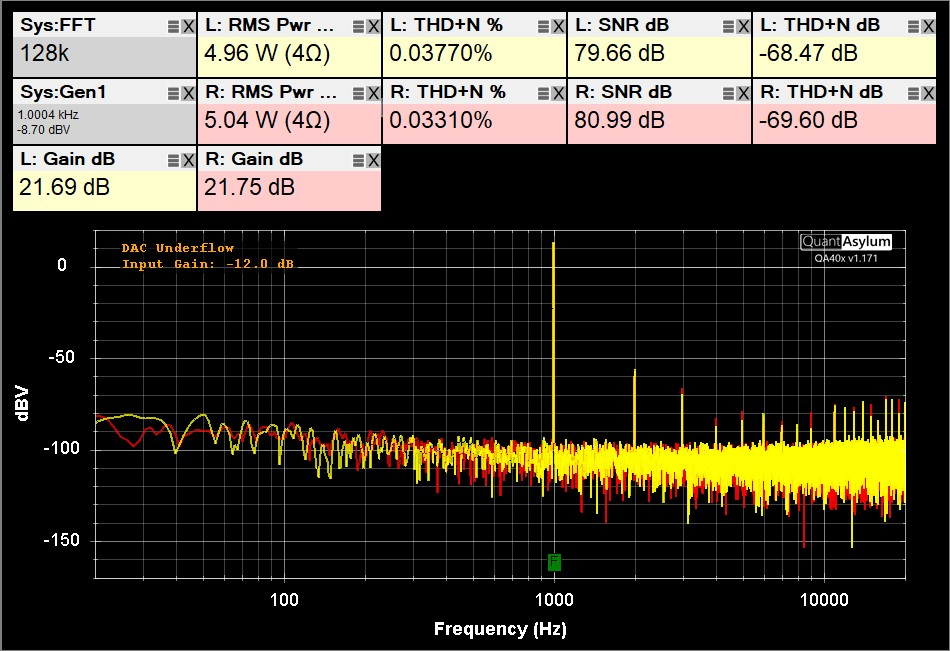
And the variable supply...
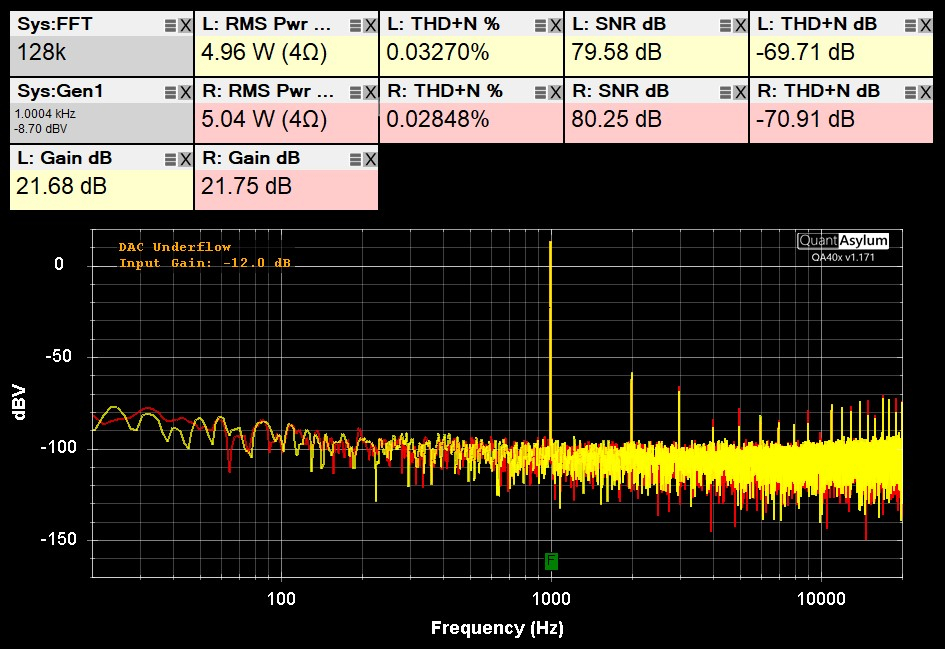
So, it's safe to say that the results are equivalent in this case - but that doesn't rule out the possibility that a different board would react differently.
Sehlin Sound Solutions
That corresponds well with what I observed. I took some measurements with the bluetooth board off.
Here is the same 24V supply voltage dashboard as the two in the previous post, but with the bluetooth board removed. No significant difference.
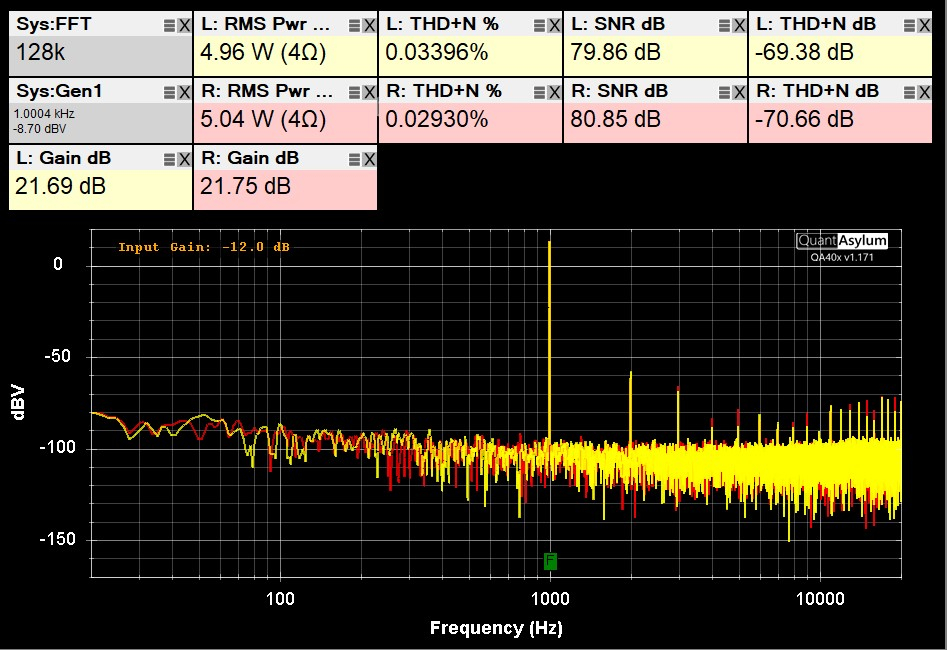
Sehlin Sound Solutions
The Tinysine DSP program uses a threshold detector to switch between the analog and BT inputs. This is from their program. Some OEMs just sum the inputs where Tinysine actually switches them.
Great insights gentleman!
Is the ADC a limiting or contributing factor? Probably not, is my scientific wild arse guess
And although I like the convenience of Bluetooth, I wonder whether the use of I2S via optical or coaxial would result in better amplifier performance?
If there’s any interest or point to testing it, perhaps Scott should notify that forum member who donated the board…
The ADC is probably a contributing factor, but I think the amp performance remains the dominant factor in the relatively poor THD+N.
The more I see of these small boards, the easier it becomes to justify ICE money.
What’s the cost of an ICE board these days with equivalent power?
I’m looking for stereo amplification and DSP and Bluetooth/digital in. For $60 a I wasn’t aware of any other solution.
An extra 10dB SNR and 3dB of gain (double power) would be handy.
This thing is getting some chatter over on DIY forums --> https://www.aliexpress.us/item/3256804709330668.html?gatewayAdapt=glo2usa
How does it measure Steve?
It seems to use the ACP Workbench app, which wouldn’t load on my previous PC, so I couldn’t tell you what the interface/options are like.
I haven't done too much research in a while, but if I was to get TPA325x I'd probably go with 3eaudio. (I have their first generation 3255 and 3351 but haven't used them). More than $60 though.
https://www.audiosciencereview.com/forum/index.php?threads/3e-audio-tpa3255-amplifier-kit-480-1-29a-review.50283/
The 3eaudio is a nice product, but It’s incredible how prices have changed (gone up!)
A decade ago, I purchased a Hypex UCD400 + 400W power supply, and it was all integrated into one block… for well..
I dragged out an old email to check… and look at the shipping costs for Netherlands to Australia!!
I cannot find data to support an opinion concerning the technical performance of the linked amps and I wont speculate. They do offer DSP EQ/XO and BT/Analogue-in though.
I thought they were interesting.
Aside, and no intention of derailing this thread but having powered DSP amps on the backs of cabinets and all of its attendant wiring and complexity has me just going back to a centralized Audio Source/DSP/Amp location with multi conductor cable to the speakers - much cleaner and less complicated.
YMMV.
100Wx2 for about $140 USD from PE--which SOUNDS like a lot on the surface, but a.) the performance is solid and b.) it brings its own integrated power supply. To keep the rest of the budget down, front it with one of the $25 Dayton bluetooth boards. I'm sure Wondom has an equivalent if the Dayton is off the table as far as customs. (edit: This guy would be ideal)
So, you're in for less than $175 from AliExpress. And those amps are a true 100W x 2 @ 4 ohms (1% THD) and the THD+N is three decimal places. I've had my ear right up to one connected to a Seas DXT, and it was dead silent. I can't say that for any other single board solution I've tried.
For DSP boards, I haven't found anything between the Tinysine/Wondom/Arylic and ICE+external DSP, and that's a shame. I know high power numbers at low prices sell for the average consumer, but if you're the sort of bloke to buy an amp with DSP capabilities that have to be programmed, I think you're also the sort of customer willing to spend a little extra for better audio performance. Another brutal reminder that the world does not regularly cater to my whims.
How is it? Easier to apply settings than Sigma, but the full capabilities require Mandarin fluency. Their "bass expander" algo is really good though. Makes an FE85 sound way bigger than it actually is.
For what it is worth, the TinySine amp has 4 gain settings. I did some testing to see if lower gain would improve performance or to what extent higher gain might hurt it. My previous measurements were at the second highest gain setting, which I will refer to as gain 2 to align with the DIP switch setting. I will start with the summary chart and some observations.
The first observation is that the measured gains were quite a bit lower than those advertised on the data sheet. Even the highest gain is somewhat lower than a typical amp board, which will be in the 27-30 dB range. The Aiyima A05, tested on Audio Science Review, had a gain of about 23 dB and similar performance. The A05 had tone controls, but not bluetooth or DSP capability, so it looks like the TinySine board managed to add that functionality without having much impact on performance.
With the lowest two gain settings, I could not drive the board to full power. With the higher two gain settings, power is likely equivalent. My test points are 1 dBV apart and the different gains had the points fall at somewhat different power levels. Here are the power curves.
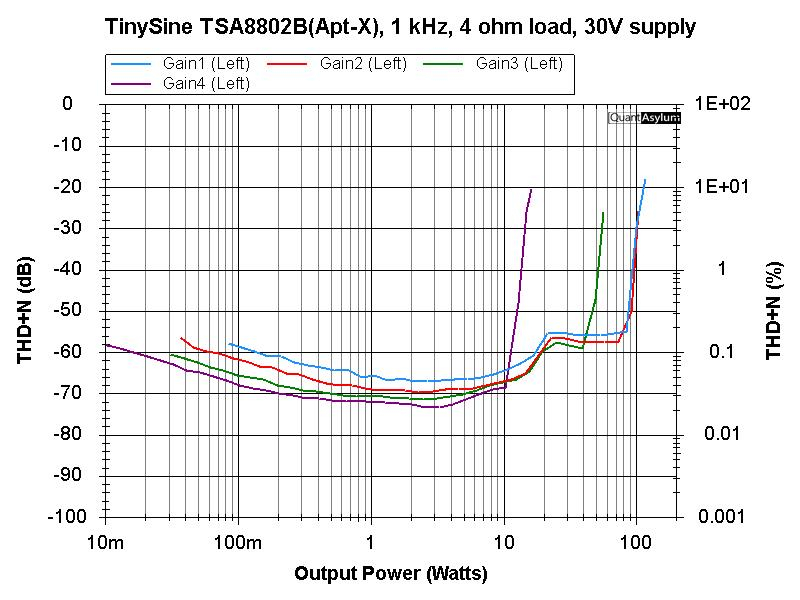
Last, I do have the dashboard charts for each of the 4 gain settings. Since they report gain, it should be clear which represents which setting. The noise floor does get lower as gain is reduced. One thing I found noteworthy is at the lowest gain setting, we see a peak start to emerge at 60 Hz, which must be power supply related. I was pretty encouraged that the 60 Hz peak is more than 90 dB down from the fundamental 1 kHz tone.
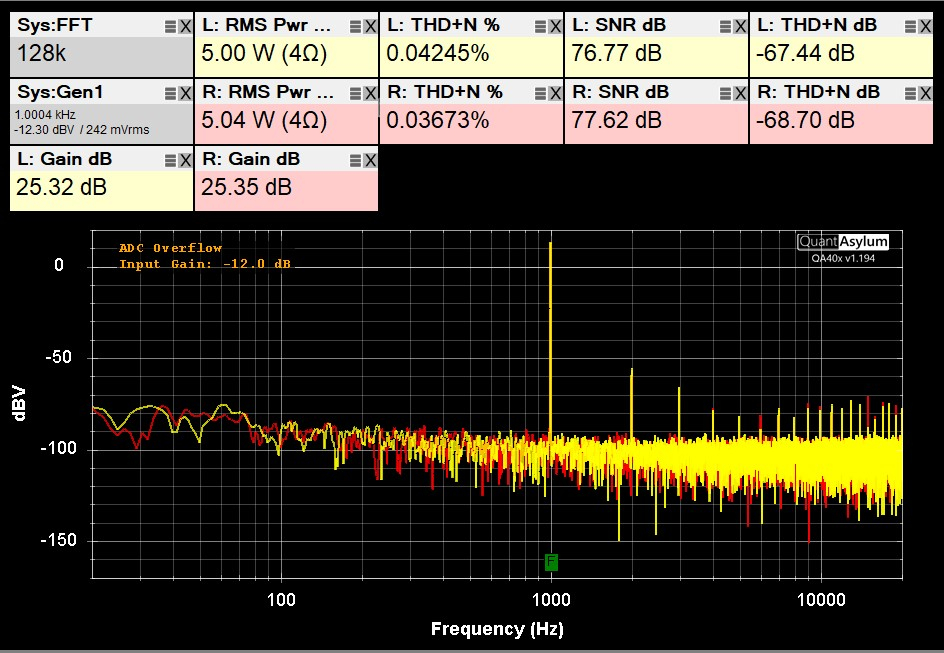
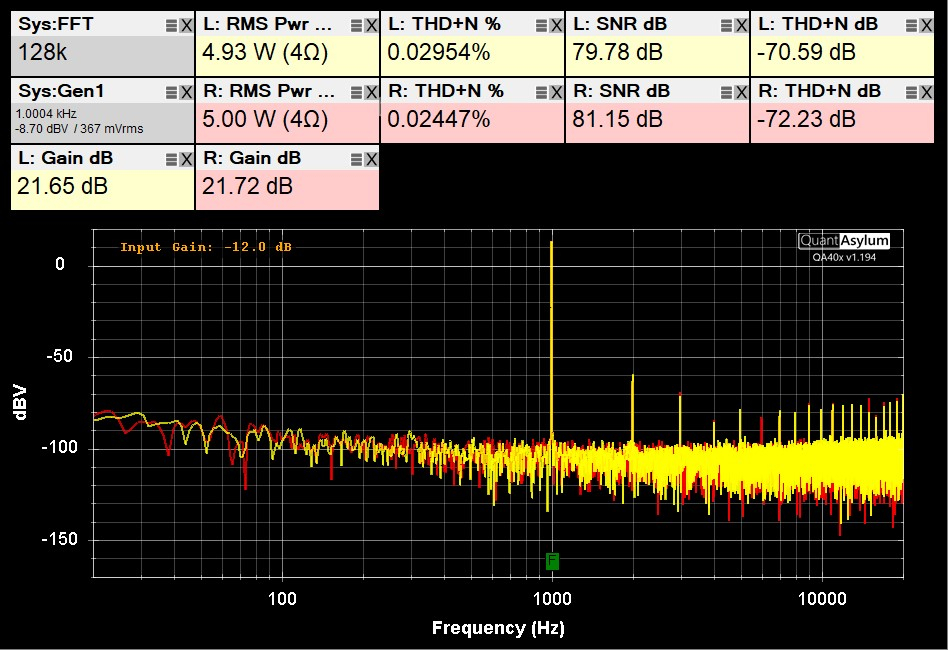
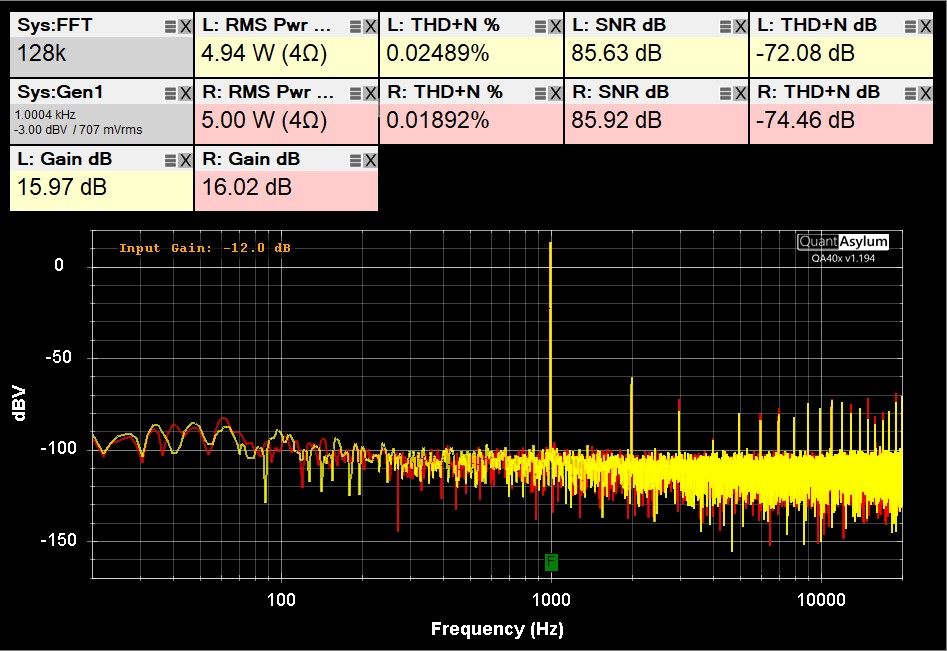

Sehlin Sound Solutions
@Dirk
I’m all for the separate DSP, amp and sources. I was a bit late getting into integrated DSPs, by the time I got around to trying the miniDSP 4x10HD championed JohnK a decade ago, it was discontinued. So I had to wait for Flex 8, which I am more than pleased with.
Here’s the test result from miniDSP’s website:
But every so often someone younger than me complains that they can’t connect its Bluetooth easily.
My kids are the age where they speak to their speakers…
So I think these all in one affordable amps/DSP/Bluetooth have their use cases. Like if one is building with scrap MDF or 3D printed casing and $20 mid-woofers and $10 tweeters, it’s a bit unreasonable to using 3 figure amp. But you can still get very good sound for a kids/college dorm room.
But DIYers are certainly playing catch-up because we don’t have access to these advanced products in unit quantities. Scott is working hard to find things that are sold at retail; because all the manufacturers are going straight for B2B. The most DIY friendly all in one board is the Hypex Fusion plate amps but last time I spoke to Hypex they had no plans for Wireless; True Wireless Stereo, or Bluetooth, let alone the more advanced lossless wireless protocols.
Scott,
Could you attempt to measure something for me using your fancy new jig ?
Could you please measure the peak voltage drop across your speaker terminals (assuming passive crossover installed) using MUSIC under "normal" listening volume and "Loud" listening volume?
I.... have been somewhat able to do this with a multimeter, but I was not confident in the sampling window. Curt C. made me MUCH smarter about counts and resolution and such. Curt is terrific ! A valid measurement solution would be a recording Oscilloscope at about $500, but if your Jig will do this - great ! I think I would get much more use from a QA403 than an Oscilloscope.
The end goal for me is building an amplifier just big enough to produce the necessary voltage/wattage.
If you are able to do this - great !
!
If your QA403 won't measure peak music voltage, please convey this too.
Thanks!
I think it should be able to do that. I can tap off the speaker terminals from a music system and feed a signal back to the QA403. The 403 can track peak and RMS voltage with its standard software. The analyzer doesn't want to see more than 32 dBV (about 40V), which I don't think will be an issue. If it is, I will need to use attenuated probes.
I think the worst case speakers I have on hand for testing from a voltage perspective are the Argons which are 8 ohms and about 80 dB (2.83V, 1m) sensitivity. I also have the Hafniums, which are similarly insensitive, but just under 4 ohms at their lowest impedance around 100 Hz.
Sehlin Sound Solutions
You could use a voltage divider circuit to half the amplifier output voltage and then correct the readings manually by doubling the voltage readings.
I would also be curious what the readings are dummy load vs a dynamic load. Some say that a speaker that is easier to drive will sound better. For some amplifiers I am sure that this is true but for most modern amplifiers they should be able to control the inductive swings with little to no degradation in sound quality.
Then there's what Seigfried Linkwitz said:
"Crossovers may be implemented either as passive RLC networks, as active filters with operational amplifier circuits or with DSP engines and software. The only excuse for passive crossovers is their low cost. Their behavior changes with the signal level dependent dynamics of the drivers. They block the power amplifier from taking maximum control over the voice coil motion. They are a waste of time, if accuracy of reproduction is the goal."
HAHAHAHAHAHAHAHAHAHA!!!
Cough
While Sigfried was way smarter than I will ever be I don't agree with this statement as an absolute. There are a plethora of examples where both the speaker and the amplifier benefit from passive components. A class D couldn't even function without an LC circuit...
If we look at power filter circuits used on other electronics we see the same components inductors, capacitors and resistors. Power filtration and controll is never done with active components alone, especially when precision is required.
Passive components are a nessisary evil.
I posted that quote just to get a reaction. I admire SL for all of his work. but I'm really more of the "It's just a matter of execution" guy. Active, passive it's all about how it's executed.
I admire SL for all of his work. but I'm really more of the "It's just a matter of execution" guy. Active, passive it's all about how it's executed.
Didn't he sell active hardware/software designs?
How long have active systems with affordable software even been available to the average Joe? Certainly a mere minute fraction of the time passive crossovers have been around. It's like history isn't a thing.
I use both, so I’m maybe about ½ right…. But reading his quote, as stated relating to crossovers, “I’ll take the Siegfried category on crossovers, for $200, Alex”